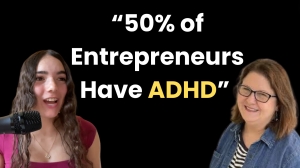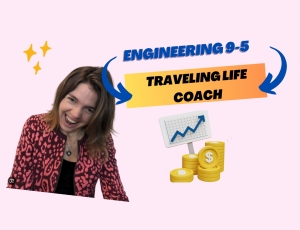The Accidental Entrepreneur: David Alemian’s Journey to Solving America’s $100 Million Problem
In the fast-paced world of business and entrepreneurship, stories of accidental success are rare. Yet, sometimes the most impactful innovations arise from unexpected places. This is precisely the case with David Alemian, America’s foremost talent retention expert, whose journey from insurance salesman to solving one of the nation’s most pressing business crises is nothing short of remarkable.
In a recent episode of the Vibrant Guide podcast, host Anna sat down with David to explore his 29-year journey, the challenges he faced, and the groundbreaking solution he developed to address the skilled labor shortage plaguing American businesses. This article delves deep into the insights shared during this enlightening conversation, offering valuable lessons for entrepreneurs, business leaders, and anyone interested in the future of work and employee retention.
The Accidental Beginning
David Alemian’s story begins like many others – with a simple job search. In his early 40s, he stumbled upon a newspaper advertisement (a relic of job hunting in the pre-digital age) for a position in the insurance industry. Little did he know that this seemingly mundane start would set him on a path to revolutionize employee retention and retirement planning.
“It’s kind of thing that gets in your blood, it just stays there,” David reflected on his entry into the insurance world. This initial step into insurance laid the foundation for his future innovations, providing him with crucial insights into financial planning and the challenges faced by both employers and employees.
Identifying the Crisis
As David’s career in insurance progressed, he began to notice a troubling trend. Around 2010, a conversation about the shortage of physicians caught his attention. Intrigued, he dug deeper, only to uncover a much larger issue:
“I found that the shortage of nurses was five times worse than the shortage of physicians. So I dug even deeper, and I found it’s not a physician shortage. It’s not a nursing shortage. It is a skills shortage. We’re short across all industries, people with skills.”
This realization was a pivotal moment for David. He recognized that the problem wasn’t isolated to healthcare but was a systemic issue affecting virtually every sector of the American economy. The shortage of skilled workers was threatening business growth, productivity, and the overall health of the U.S. economy.
The Scale of the Problem
To truly appreciate the innovation of David’s solution, it’s crucial to understand the magnitude of the problem he set out to solve. According to David, almost 80% of employers in the United States struggle with a shortage of skilled labor. This isn’t just a minor inconvenience; it’s a crisis that costs businesses millions of dollars annually and hampers economic growth.
The root of the problem lies in the intersection of demographic shifts, evolving workforce dynamics, and inadequate retention strategies. As baby boomers retire, taking their skills and experience with them, companies are left scrambling to fill critical positions. Simultaneously, younger generations are more prone to job-hopping, seeking better opportunities and work-life balance.
“Turnover occurs on average in the US every 4.1 years,” David explained. “That’s the Department of Labor’s statistic. In the C-suite, it’s a little long, between five and six years, but these people are hopping from job to job.”
The cost of this turnover is staggering. According to David’s research, replacing an employee costs an average of 213% of their annual salary. When you factor in the frequency of turnover, companies are essentially adding 53% to their payroll costs just to maintain their workforce.
The Eureka Moment
As David pondered this complex issue, he had a realization that would shape his revolutionary approach. He recalled a time when employees would spend their entire careers with one or two companies, primarily motivated by the promise of a lifetime pension.
“I found that there was a time when people spent their entire career one maybe two companies. And why was that? It’s because they wanted that lifetime pension and they would stay with a company for as long as it took to get it.”
This insight led David to a crucial question: Could a modern equivalent of the pension system be created that would benefit both employees and employers, addressing the dual challenges of retention and retirement security?
The Innovation: Merging Retention with Retirement
David’s solution is elegantly simple in concept but profound in its implications. He developed a strategy that merges employee retention with robust retirement savings plans. This approach, which took 12 years to fully develop, creates a win-win situation for both employers and employees.
At its core, David’s innovation is a supplemental employee retirement plan. Unlike traditional 401(k) plans, which are portable and don’t incentivize long-term employment with a single company, David’s plan is designed to reward loyalty and longevity.
“I create something called supplemental employee retirement plans,” David explained. “It’s a retirement benefit that can be made big enough to be equal to or greater than the employee’s working year’s income. And it’s for life.”
The key features of this plan include:
1. Employer-Funded: The employer pays for the plan 100%, costing the employee nothing.
2. Contractual Commitment: In exchange for this generous benefit, the employee agrees to stay with the company for a specified period, which could range from five years to retirement.
3. Asset, Not Liability: Unlike traditional benefits that are expenses or liabilities for the company, this plan is structured as an asset that grows and compounds over time.
4. Protection for Both Parties: The plan includes provisions to protect both the employer and employee in various scenarios, including early departure, illness, or death.
5. Lifetime Income: If the employee fulfills their commitment, they receive a lifetime income that equals or exceeds their working years’ income.
6. Inflation Protection: The plan even includes a mechanism to increase the retirement income mid-retirement to help keep pace with inflation.
The Impact on Employers
For employers, the benefits of this innovative approach are numerous:
1. Reduced Turnover: By providing a compelling reason for employees to stay long-term, companies can dramatically reduce their turnover rates and associated costs.
2. Attraction of Top Talent: The promise of true financial security in retirement becomes a powerful recruiting tool, helping companies attract the best and brightest in their field.
3. Improved Productivity: With a stable, experienced workforce, companies can benefit from increased productivity and institutional knowledge retention.
4. Financial Advantage: Unlike traditional benefits, this plan is structured as an asset on the company’s books, potentially improving their financial position.
5. Risk Mitigation: The plan includes provisions that protect the company’s investment if an employee leaves prematurely or is unable to work due to illness.
The Impact on Employees
For employees, the advantages are equally significant:
1. True Financial Security: Unlike 401(k) plans, which can be depleted due to market volatility or outliving one’s savings, this plan provides a guaranteed lifetime income.
2. No Financial Sacrifice: Employees don’t have to choose between current lifestyle and saving for retirement, addressing a common dilemma faced by many workers.
3. Protection Against Inflation: The plan’s design helps ensure that the retirement income keeps pace with inflation, maintaining purchasing power over time.
4. Peace of Mind: Knowing that their retirement is secure allows employees to focus on their work and personal lives without the stress of financial uncertainty.
5. Illness and Death Benefits: The plan includes provisions to support employees and their families in case of illness or premature death.
A Case Study in Success
To illustrate the power of his approach, David shared a success story during the podcast. He worked with a healthcare organization located in a challenging desert environment, where attracting and retaining talent was particularly difficult due to the harsh climate and rural location.
This organization grew from a $40 million operation to approximately $100 million. Then, about four years ago, the top three leaders of this nonprofit started a second, for-profit organization. In just four years, they built this new venture from zero to $80 million in annual revenue.
Recognizing the value of these leaders, the board of directors wanted to ensure their long-term commitment to the company. They implemented David’s retirement benefit plan, customized for each leader based on their expected time until retirement.
“So what they did here was they solidified these people who were amazing performers so that this company will continue to grow for years to come,” David explained.
This case study demonstrates how David’s solution can be applied not just to retain employees, but to secure the long-term commitment of key leadership talent, ensuring continuity and sustained growth for the organization.
The Broader Implications
David’s innovation has implications that extend far beyond individual companies. By addressing the skilled labor shortage and providing a path to financial security for workers, this approach has the potential to strengthen the entire U.S. economy.
Moreover, it represents a shift in thinking about the relationship between employers and employees. Rather than viewing labor as a transactional commodity, it encourages a long-term partnership that benefits both parties.
This approach also has the potential to address some of the systemic issues in retirement planning that have emerged since the shift from pensions to 401(k) plans in the late 1970s and early 1980s. As David pointed out, the current system often leaves retirees vulnerable:
“The average 401(k), before inflation came along, the average 401(k) ran out of money in 12 to 14 years. And what do you know? And it does it for two reasons. One, taxes, two, inflation, and that’s gone through the roof. So instead of being 12 to 14 years, it’s a lot shorter now.”
By providing a guaranteed lifetime income, David’s solution could help prevent the financial insecurity that many retirees face today.
The Mind of an Innovator
One of the most fascinating aspects of David’s story is his approach to problem-solving. He describes himself as a “visual mathematician,” someone who can see seemingly unrelated pieces of a puzzle and put them together to form a complete picture.
“A visual mathematician is someone who can see seemingly unrelated pieces of a puzzle and put them together to form a complete picture. And I just do that naturally. It just happens,” David explained.
He attributes his problem-solving ability to four key characteristics:
1. IQ
2. Math ability
3. Spatial recognition
4. Pattern recognition
David’s ability to excel in all four of these areas allows him to approach problems from unique angles and develop innovative solutions that others might miss.
This approach was evident in how he tackled the talent retention problem. By linking two seemingly unrelated issues – employee retention and retirement security – he created a solution that addresses both simultaneously.
Lessons for Entrepreneurs
David’s journey offers valuable lessons for aspiring entrepreneurs and business leaders:
1. Identify Hidden Connections: Look for connections between seemingly unrelated problems or ideas. Sometimes, the most innovative solutions come from bridging disparate concepts.
2. Persistence is Key: David spent 12 years developing his solution. Innovation often requires long-term commitment and the willingness to refine ideas over time.
3. Start with What You Know: David’s background in insurance provided the foundation for his innovation. Your existing knowledge and experience can be the springboard for groundbreaking ideas.
4. Think Big: David’s solution doesn’t just help individual companies; it has the potential to address a national economic issue. Don’t be afraid to tackle big problems.
5. Focus on Win-Win Solutions: The most impactful innovations often create value for multiple stakeholders simultaneously.
6. Be Willing to Disrupt: David’s approach challenges the dominance of the 401(k) system. Sometimes, creating real change requires being willing to upset established norms.
Overcoming Challenges
Like any entrepreneurial journey, David’s path was not without obstacles. He faced several challenges in developing and implementing his talent retention strategy:
1. Time: Developing a comprehensive solution to such a complex problem took years of work and refinement.
2. Access to Decision Makers: Even with a great solution, reaching the right people who could implement it was a significant hurdle.
3. Changing Established Mindsets: Convincing companies to adopt a new approach to retention and retirement benefits required overcoming ingrained ways of thinking.
David’s advice for overcoming such challenges? “Belief, knowing that what you’re doing is the right thing,” he said. “You’re gonna have obstacles. There are gonna be bumps in the road. There are gonna be huge walls that are gonna come up in your way. But if what you have is big enough or what you’re striving toward is big enough, then it will blow through any roadblock that comes your way.”
The Future of Talent Retention
Looking ahead, David sees his solution as a potential disruptor in the world of employee benefits and talent retention. He believes it could challenge the dominance of the 401(k) plan, much like the 401(k) disrupted traditional pension plans in the 1980s.
“I see this plan as a way to disrupt the 401(k),” David stated. “I mean, you could add it to the 401(k), that’s fine. But it’s going to be far more popular. Why? Because one, it’s not a cost. It is an asset on the company’s books and two, it provides the employee with true financial security.”
As remote work becomes more prevalent and digital transformation continues to reshape industries, David’s approach offers a way for companies to maintain strong connections with their employees, regardless of physical location.
Moreover, with the talent shortage expected to persist well beyond 2075, according to David’s projections, solutions like his will likely become increasingly crucial for businesses looking to secure the skilled workforce they need to thrive.
Advice for Building Loyal Teams
For entrepreneurs and business owners looking to build loyal and motivated teams, David offers this advice: “Put your people first. Be good to your people.”
He suggests that implementing a plan like his is one of the most concrete ways to demonstrate commitment to employees’ long-term well-being. By providing true financial security, companies can inspire their employees to build careers rather than just take jobs.
“They will stand and they will build their career instead of taking a career and hopping from one job to the next. Plan it from the very beginning and say, you know, this is a company that I could have a future with. I could build something here,” David explained.
The Power of Mentorship and Continuous Learning
Throughout the podcast, David emphasized the importance of mentorship and continuous learning in entrepreneurial success. He advises aspiring entrepreneurs to seek out mentors who have achieved what they aspire to accomplish:
“Get a mentor, get a coach, get someone who’s been to where you want to go and let them be your guide, let them help you. And many times when you have a coach, you have a guide, you’re getting advice from someone, as I said, who’s been there and they don’t have any other agenda other than your success.”
This advice underscores the value of learning from others’ experiences and the power of having someone in your corner who is invested in your success.
The Importance of Starting
One of the most powerful pieces of advice David offered during the podcast was about the importance of taking that first step. When asked how to start when you’re at zero and want to get to 100, David referenced “The Wizard of Oz”:
“Glenda, she said, well, it’s always best to start at the beginning. Just start. As you start and you move forward, you start to get more momentum.”
He compared the process to rolling a snowball down a hill, starting small but gathering size and speed as it goes. This metaphor beautifully captures the entrepreneurial journey – it often starts with a small step, but with persistence and momentum, it can grow into something truly impactful.
“You don’t have to wait until all your ducks are in a row. You don’t have to wait until everything’s perfect because it never will be. It just won’t. It doesn’t have to be perfect. It just has to be good enough. Start.”
This advice is particularly valuable for young entrepreneurs who might feel overwhelmed by the magnitude of the problems they want to solve or the goals they want to achieve. David’s journey proves that even the most significant innovations can start with a single step.
Spreading the Message
Today, David is focused on sharing his solution with as many business leaders as possible. He speaks at conferences, seeing these events as opportunities to create a ripple effect of positive change:
“When I speak at conferences, I can help so many people. If I have a room of 400 business leaders, I can help all of them. Will they all ask my help? No, but enough will. But then what happens is when I help them, now I’m helping their employees.”
His goal is to give talks every week around the country, maximizing the reach and impact of his solution. This commitment to education and outreach demonstrates David’s understanding that true innovation doesn’t just solve a problem – it changes the way people think about and approach that problem.
Conclusion
David Alemian’s journey from insurance salesman to America’s foremost talent retention expert is a testament to the power of innovative thinking, persistence, and a genuine desire to solve significant problems. His story offers valuable lessons for entrepreneurs, business leaders, and anyone interested in the future of work and retirement planning.
By identifying the connection between employee retention and retirement security, David has developed a solution that has the potential to address one of the most pressing issues facing American businesses today. His approach not only offers a way for companies to retain their most valuable asset – their skilled employees – but also provides workers with the financial security they need.
🔗 CONNECT WITH DAVID:
Website: https://davidalemian.com
Linkedin: https://www.linkedin.com/in/davidalemian/
YouTube: https://www.youtube.com/c/DavidAlemian/videos?app=desktop










Leave a Reply
Want to join the discussion?Feel free to contribute!